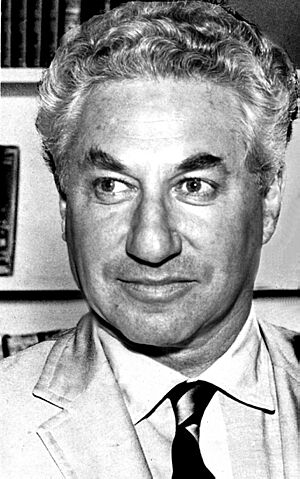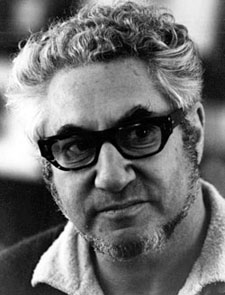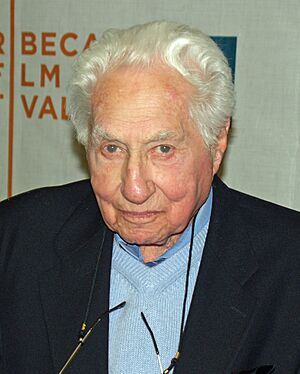Budd Schulberg facts for kids
Quick facts for kids
Budd Schulberg
|
|
|---|---|

Schulberg in 1967
|
|
| Born | Seymour Wilson Schulberg March 27, 1914 New York City, New York, U.S. |
| Died | August 5, 2009 (aged 95) Westhampton Beach, New York, U.S. |
| Occupation |
|
| Period | 1937–1982 |
| Spouse |
Virginia Lee Ray
(m. 1936; div. 1942)Agnes Victoria Anderson
(m. 1943; div. 1964)Geraldine Brooks
(m. 1964; died 1977)Betsy Ann Langman
(m. 1978) |
| Children | 5 |
| Parents | B. P. Schulberg Adeline Jaffe |
| Relatives | Sam Jaffe (uncle) |
Budd Schulberg (born Seymour Wilson Schulberg, March 27, 1914 – August 5, 2009) was an American writer. He wrote for movies, television, and also wrote novels and sports articles. He is famous for his novels What Makes Sammy Run? (1941) and The Harder They Fall (1947). He also wrote screenplays for popular films like On the Waterfront (1954) and A Face in the Crowd (1957). He won an Academy Award for On the Waterfront.
Contents
Growing Up and School
Budd Schulberg grew up in a Jewish family. His father, B. P. Schulberg, was a famous Hollywood film producer. His mother, Adeline Schulberg, started a talent agency. Her brother, Sam Jaffe, later took over the agency.
Budd went to Deerfield Academy for high school. Then he attended Dartmouth College. While at Dartmouth, he worked on the school's humor magazine. In 1939, he helped write a movie script called Winter Carnival. This movie was set at Dartmouth. Famous writer F. Scott Fitzgerald also worked on the script for a short time. Dartmouth College gave Schulberg an honorary degree in 1960.
World War II Service
During World War II, Schulberg joined the Navy. He worked with the Office of Strategic Services (OSS). This group created documentaries. He was part of a team led by film director John Ford.
After the war ended in Europe (VE Day), Schulberg saw the liberation of Nazi concentration camps. He helped gather evidence against war criminals for the Nuremberg Trials. One of his tasks was to find Leni Riefenstahl. She was a filmmaker who made Nazi propaganda movies. Schulberg wanted her to help identify Nazi officials in old German film footage.
Schulberg and his brother, Stuart Schulberg, presented two important films at the trials. These films were Nazi Concentration Camps and The Nazi Plan. The first film showed real footage from the camps. The second used German films to show the Nazi plan.
His Writing Career
Budd Schulberg grew up around Hollywood. This gave him a special view of how the film industry really worked. He used this knowledge in his writing.
His 1941 novel, What Makes Sammy Run?, showed the tough side of Hollywood. It followed a character named Sammy Glick as he rose to power. Schulberg was once part of the Communist Party USA. However, he left after party leaders tried to tell him what to write in his novel.
In 1950, Schulberg published The Disenchanted. This book was about a young writer working with an older, famous novelist. Many people thought the older novelist character was based on F. Scott Fitzgerald. The book became a bestseller. It was later made into a play on Broadway.
Schulberg also wrote the 1957 film A Face in the Crowd. This movie starred Andy Griffith. Griffith played a country singer who becomes very famous. The film shows how he uses his power to control people.
In 1951, Schulberg testified to the House Un-American Activities Committee (HUAC). He explained how Communist Party members had tried to influence his book, What Makes Sammy Run?.
Beyond novels and screenplays, Schulberg was also a sports writer. He was the chief boxing writer for Sports Illustrated. He wrote books about boxing, like Sparring with Hemingway. In 2002, he was added to the International Boxing Hall of Fame for his contributions to the sport.
After the Watts riots in Los Angeles in 1965, Schulberg started the Watts Writers Workshop. This workshop helped people in the Watts area learn artistic skills. It aimed to help ease frustrations in the community.
In 1981, Schulberg wrote his autobiography, Moving Pictures: Memories of a Hollywood Prince. It shared his memories of growing up in Hollywood in the 1920s and 1930s. His father was the head of Paramount Studios at the time.
Family and Later Life
Budd Schulberg was married four times and had five children. His last marriage was to Betsy Ann Langman in 1977. They had two children, Benn and Jessica.
His niece, Sandra Schulberg, was an executive producer for the film Quills. His mother, Adeline Schulberg, was his agent for many years. His brother, Stuart Schulberg, was a movie and television producer. His sister, Sonya Schulberg, was also a writer.
Budd Schulberg passed away on August 5, 2009, at his home in Westhampton Beach, New York. He was 95 years old.
Films and TV Shows
- A Star Is Born (1937) - uncredited writer
- Nothing Sacred (1937) - uncredited writer
- On the Waterfront (1954) - story, script
- The Harder They Fall (1956) - based on his novel
- A Face in the Crowd (1957) - story, script
- Wind Across the Everglades (1958) - script, producer, uncredited director
See also
 In Spanish: Budd Schulberg para niños
In Spanish: Budd Schulberg para niños
- The Nazi Plan



